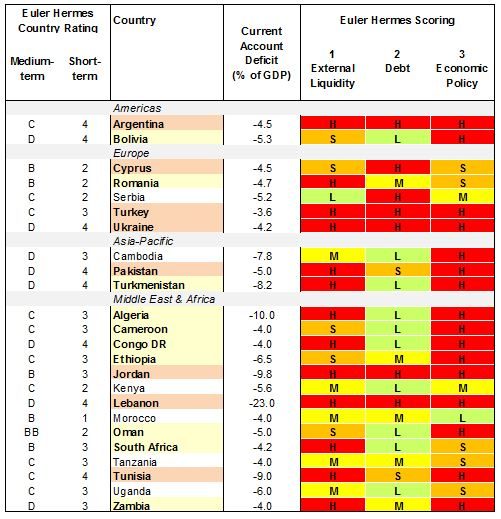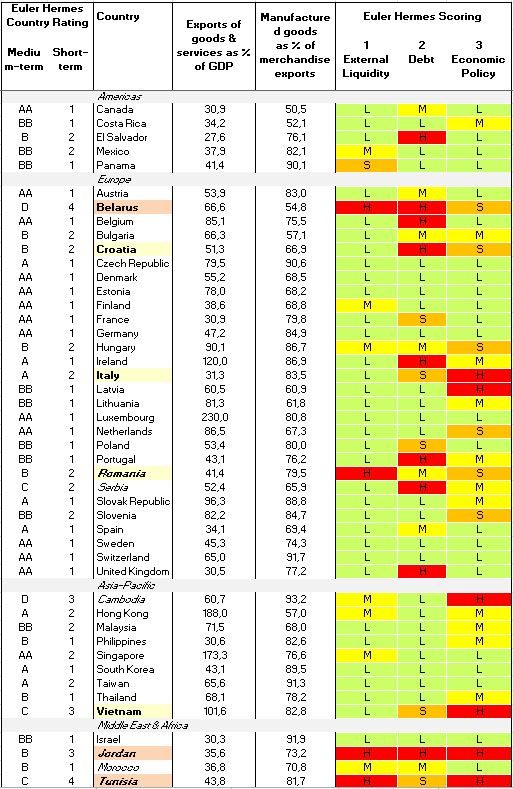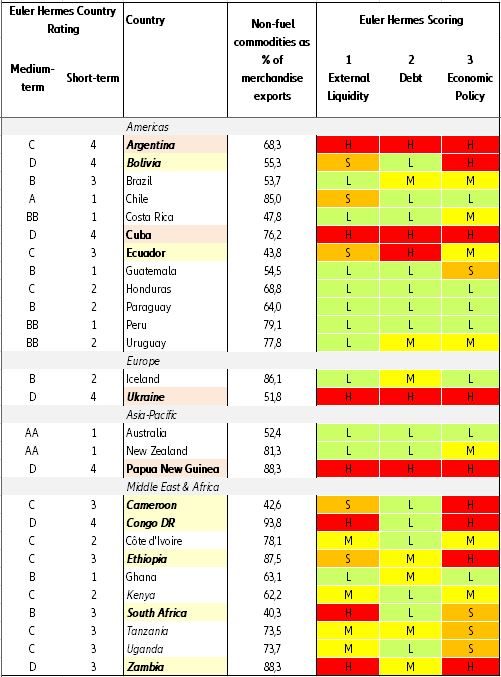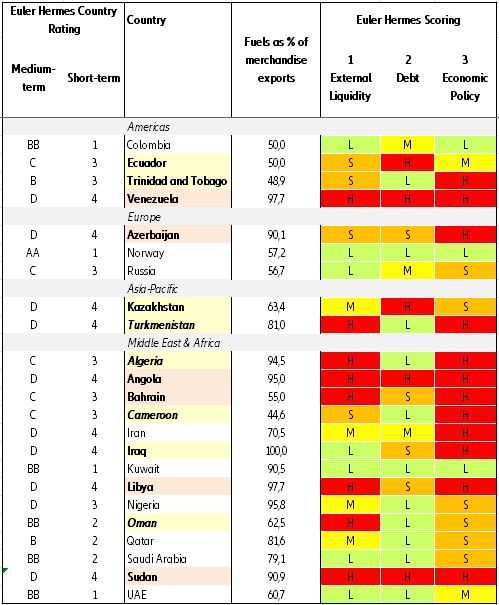- Annual global economic growth peaked in 2017-2018 and we forecast a soft landing of the world economy in 2019 and 2020. Against this backdrop, we studied the main transmission routes of a global slowdown to individual economies and identified countries that are the most vulnerable along three channels: external financing, trade and commodity prices.
- Our analysis shows six countries are particularly at risk in the event of a (sharper than currently expected) global downturn: Argentina, Tunisia, Bahrain, Turkey, Jordan and Cyprus. Another 12 countries are “more vulnerable” and would require close monitoring should the global downturn turn out to be particularly strong. This list also includes one advanced economy: Italy.
- As for emerging markets, many of them are more resilient to external shocks or a global slowdown than before the 2008/2009 Global Recession, thanks to better policies and the accumulation of sufficient foreign exchange reserves over the past decade.
- Along the external financing channel, there are 18 economies that are notably more vulnerable than others. Eight of them are highly exposed to a global slump (including Argentina, Turkey, Cyprus and Tunisia).
- Looking at the (merchandise) trade channel, we identify 45 economies (including many advanced economies) that are very export-dependent and thus are likely to experience a significant cyclical slowdown. Seven of these countries face higher systemic economic risks in the context of overall external liquidity, public and external debt ratios and macroeconomic policies (including Italy, Romania, Croatia and Vietnam).
- Along the commodity prices channel, there are 11 important non-fuel commodity exporters (including Argentina and South Africa) and 14 important energy exporters (including Algeria and Oman) which are identified as more vulnerable to a global downturn.
Where we are now
Annual global economic growth peaked in 2017-2018. In our central scenario, we forecast a soft landing of the world economy, with global real GDP growth easing from +3.1% in 2018 to 3.0% in 2019 and 2.7% in 2020. The expansion of the volume of global trade in goods and services is projected to moderate from +3.8% in 2018 to +3.6% in 2019. However, there are considerable (and perhaps growing) downside risks to this relatively benign scenario because global trade tensions are still ongoing, for example, and stuttering growth in Germany and France may impact the economic performance of the whole of Europe. Meanwhile, slower growth than projected in China could affect other economies in Asia and elsewhere. Currently we assign a combined probability of 40% to downside scenarios in which the global slowdown will – sooner or later – be much sharper than in our soft landing scenario.
Against this backdrop, this article looks at the main transmission routes of a global slowdown to individual economies and identifies countries that are the most vulnerable along each of these channels. The three channels are external financing, trade and commodity prices.
The analysis applies most of the economic indicators that are used in the underlying macroeconomic scoring model of the Euler Hermes Country Rating. However, it should be noted that while this exercise highlights potential stress points, it is not intended to be a predictor of the systemic collapse of a country. Neither is it a comprehensive assessment of country risk. That is contained in the overall Country Rating assigned by Euler Hermes’ in-house methodology, which takes into account important factors such as the business environment and government stability and effectiveness. This allows for the fact that some governments may already have begun to adjust policies to changing global realities or are in a strong position to take remedial action if needed.
Nonetheless, this analysis does highlight the economies which, in our view, could be hardest hit by suddenly tightening external financing conditions, absent appropriate policy adjustment, and/or through loss of export demand, compounded by poor policies and a weak external liquidity and debt position (again absent of appropriate corrective policies). It also indicates the more vulnerable economies should commodity prices fall unexpectedly sharply. It should be noted further that this analysis does not aim to identify a specific trigger for any potentially sharp or sudden global downturn – it rather provides a watchlist of susceptible countries should such a scenario materialize.
In other words, we think the Country Ratings of economies identified as more vulnerable are still appropriate at this point, but nevertheless those countries warrant close attention, particularly the larger markets. Should the global slowdown turn out to be more sharp than currently expected, it could tip marginal ratings into a higher risk category.
Vulnerability Channel #1: External Financing
As a starting point, we identify those economies with a large current account deficit. The rationale is that the current account is the most often-cited “headline” measure of vulnerability. However, the current account in itself is not the whole story. A better measure of vulnerability is to set a large current account deficit in the context of:
- overall external liquidity,
- public and external debt ratios, and
- macroeconomic policy indicators.
Those countries most vulnerable along financial channels are the ones with wide current account deficits, weak external liquidity indicators overall, high debt ratios and already poor policy indicators. On the other hand, countries that have sufficient buffers with regard to external liquidity and debt and a solid policy performance are better positioned to withstand a sudden disruption to financing flows, even if they have a relatively large external deficit.
Table 1 shows those economies with a GDP of more than USD20bn that had an estimated current account deficit of more than -4% of GDP in 2018. Turkey has also been included in the table as it continues to face high downside risks, even though its external deficit is already in the process of rebalancing and has narrowed to below -4% of GDP after it experienced a serious currency crisis in 2018. Nonetheless, Turkey is not out of the woods yet, and its recovery could be disrupted by a global downturn.
Countries that have a High (H) or a combination of High (H) and Significant (S) risks in columns 1, 2 and 3 are the most vulnerable along the external financing channel of transmission and, other things equal, would require the strongest corrective action to avoid a crisis in the event of financing becoming suddenly more restrictive. Moderate (M) risk can be considered as a relatively mild early-warning signal, while Low (L) risk can be considered as relatively insignificant in this context.
Eight of the 24 countries in Table 1 flag a High (H) or Significant (S) risk in each of the columns 1, 2 and 3 (those highlighted in light orange). Apart from Argentina and Turkey, which are already in crisis, there are three countries from MENA, two others from Europe and one from Asia. This group of economies would be the most vulnerable if external financing would become scarcer in the event of a significant global slowdown and should be monitored closely then. It includes Cyprus, which currently has a Short-Term Country Rating of “2” at Euler Hermes, while the other seven are already rated “3” or “4”, reflecting high country risk.
Another ten of the 24 countries in Table 1 flag a High (H) or Significant (S) risk in two of the columns 1, 2 and 3 (those highlighted in light yellow). These economies – including Romania, South Africa, Algeria and Oman – would be more vulnerable and should be monitored more closely in the event of a particularly sharp (and sudden) global slowdown.
Table 1: External financing route vulnerability








